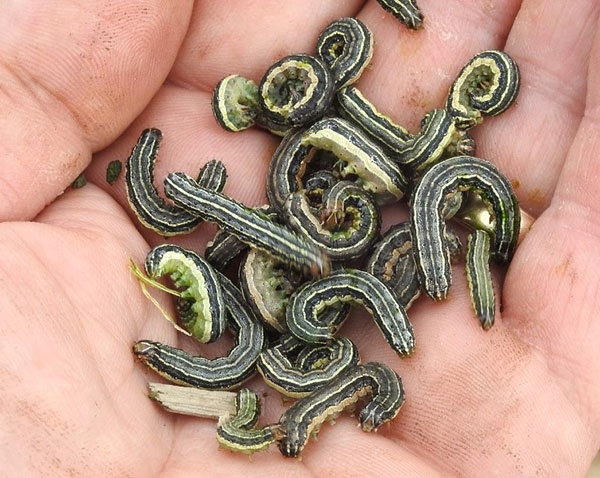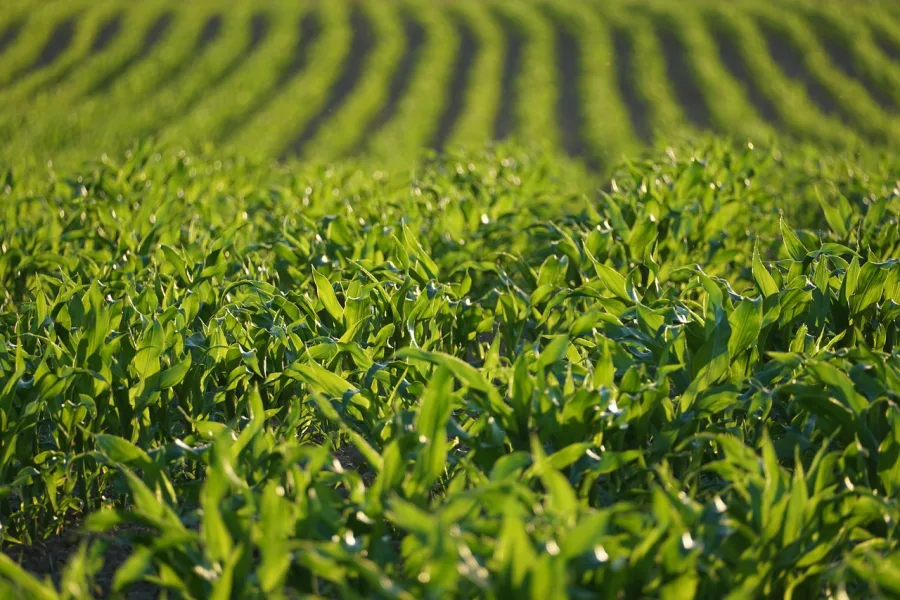Learn how to identify and control fall armyworms before they devastate your crops. Discover effective scouting tips and treatment strategies to protect your fields.

Invasive pests, such as fall armyworms, travel northward as temperatures increase and persist year-round in warmer southern American environments. Their thirty-day life cycle consists of egg, larva, pupa, and adult moth. The larvae do the most significant harm, eating crops like maize, alfalfa, pasture grasses, rye, wheat, and triticale.
“Fall armyworms can decimate entire fields in days,” Iowa State University Field Agronomist Virgil Schmitt stresses. Early identification and quick response are thus very vital in controlling these pests.
Being proactive and in control is critical in the face of fall armyworms. Early identification and swift management are essential, as these pests can rapidly turn fields to stubs if not managed promptly.
Fall Armyworms: A Global Agricultural Threat of Significant Proportions
The famously flexible fall armyworms, Spodoptera frugiperda, pose a significant global agricultural danger. Their ability to seriously jeopardize world food security and ruin many crops was initially documented in West and Central Africa in 2016.
Understanding the life cycle of the fall armyworm is crucial. It includes four phases: egg, larva, pupa, and adult moth. The larval stage is the most devastating, as the larvae ravenously eat leaves, stalks, and flowers. They even move and spread via silk threads, causing severe damage to crops.
Rising temperatures let these pests exist year-round in the southern United States, but once spring approaches, they travel north. Experts Casey Reynolds, Mike Merchant, and Diane Silcox Reynolds say they finish their life cycle every 30 days and create many generations yearly. This fast life cycle emphasizes how urgently early diagnosis and control are needed.
Susceptible Crops and Agronomic Factors Contributing to Armyworm Infestations
Because their soft leaves provide perfect nourishment for the larvae, fall armyworms attack crops like maize, alfalfa, pasture grasses, rye, wheat, and triticale. Late planting, less tillage, and utilizing non-Bt hybrids without lepidopteran control all increase susceptibility. As breeding grounds, spring cover crops may cause infestations in other areas after harvest.
Scouting for Armyworms: Optimal Timing and Identification Tips
Scouting for armyworms is a crucial task that requires vigilance and attention to detail. Emphasizing the best periods, like dawn or sunset, when fall armyworms are most active and evident on the vegetation can help with identification and management.
Armyworms hide in the whorl of a corn stalk or curl up in the debris at the base of the plant during the day. Examine closely the lowest sections of the plants and plant trash. Ignoring these warning signals may cause a full-fledged epidemic.
Search for larvae whose heads show an inverted “Y” to set fall armyworms apart from other pests. Usually green, brown, or black, these insects have smooth bodies and lengthy “i” stripes down their sides. Accurate scouting and suitable pest control depend on awareness of these traits, which will arm you in your efforts.
Being alert in your scouting can help significantly lessen the damage autumn armyworms do to your crops. Apply these guidelines to keep a field in an excellent and productive state.
Preventive Strategies: Safeguarding Your Crops from Fall Armyworms
Preventive actions are essential for protecting crops against fall armyworms. Crop rotation, which provides a regular food supply, might disturb their life cycle and lower their number. Additionally, integrated pest management (IPM), which includes introducing armyworm natural predators, strengthens defenses. Healthy soil supports vigorous plants that better fight pests. Amendments to organic matter and soil may help increase water retention, fertility, and soil structure.
Healthy soil supports vigorous plants that better fight pests. Amendments to organic matter and soil may help increase water retention, fertility, and soil structure. Additionally, integrated pest management (IPM), which includes introducing armyworm natural predators, strengthens defenses.
Though they must be used wisely, cover crops may help control pests. Before starting major crops, terminate cover crops to prevent providing an armyworm home—for instance, an infestation results from planting maize onto a rye cover crop without adequately tending it.
These steps can help significantly lower the fall armyworm risk in your farming operations and support agricultural sustainability.
Effective Foliar Insecticide Use and Integrated Pest Management Strategies for Fall Armyworms
Fighting fall armyworm infestations usually starts with foliar pesticides. They provide rapid control when applied to crop leaves where the larvae feed. Success depends on using application rules.
Timing is critical. Targeting larvae less than ¾ inch in size is both economical and successful. More giant larvae cease eating near pupation and are more difficult to kill. Early action with appropriate pesticides lessens crop damage.
Following pre-harvest intervals (PHI) on labels is very essential. PHI ensures customer safety and crop acceptability by indicating the days between the last treatment and harvest, preventing unlawful pesticide residues.
Furthermore, integrated pest management (IPM) should be used. Combining resistant cultivars, crop rotation, chemical treatments, and biological controls helps reduce resistance and encourages sustainable farming.
Effective autumn armyworm control depends on proactive monitoring and quick responses safeguarding food security and crop productivity.
The Economic Imperative of Early Fall Armyworm Intervention
Fall armyworms have a significant economic influence as they can quickly destroy vast tracts of priceless crops. These infestations not only lower yields but also raise control-measure-related expenditures. Iowa State University Field Agronomist Virgil Schmitt believes early intervention is economically vital. Tiny larvae, usually 3/4-inch or less, are more sensitive to pesticides, so early treatment is economical and successful.
This technique depends heavily on timely scouting. Early detection of fall armyworm larvae enables quick response that helps to avoid significant damage, which requires more forceful and costly solutions. Scouting during ideal periods, like dawn or sunset, improves the management of infestations before they spread, reducing crop loss and safeguarding agricultural output.
Early diagnosis and treatment provide financial advantages beyond short-term cost reductions. Maintaining good crops helps prevent the broader consequences of lower yields, which can affect supply networks, market pricing, and world food security. Integrated pest control plans aimed at safeguarding agricultural investments and economic stability depend critically on the cost-effectiveness of early intervention.
Prompt treatment and attentive scouting help support the long-term viability of agricultural activities and help lower the financial effects of autumn armyworm damage. Prevention is worth a pound of cure.
The Bottom Line
Fall armyworms seriously threaten crops throughout the United States, particularly in the southern states, where they flourish year-round and travel north as temperatures increase. Consuming foods like maize, alfalfa, and cereals, the most damaging larvae eat also.
Armyworms are nocturnal and more challenging to find during the day; hence, proactive scouting during twilight hours is rather important. Although foliar pesticides might be helpful, timely treatment is essential in small larvae cases.
Preventive actions and combined pest control plans are essential. Early intervention lessens economic losses and helps maintain agricultural production.
Regular scouting, quick treatment, and thorough pest control help protect crops against autumn armyworm infestations, guaranteeing robust agricultural methods and safe food output.
Key Takeaways:
- Fall armyworms can survive year-round in southern U.S. climates and migrate northward as temperatures rise.
- They complete their life cycle every 30 days, with the larval stage being the most destructive.
- Commonly affected crops include corn, alfalfa, pasture grasses, rye, wheat, and triticale.
- Spring cover crops are a significant habitat for armyworms, which can infest subsequent crops or nearby fields once harvested.
- Scouting should be done at sunrise or sunset when armyworms are most active, using tips from agronomy experts to differentiate them from other pests.
- Corn crops in the southern U.S. and Texas, particularly late-planted or non-Bt hybrids, are at higher risk.
- Prompt treatment with labeled foliar insecticides is crucial when scouting thresholds indicate the necessity.
- Smaller larvae (3/4-inch or less) are easier to eliminate and should be targeted for the best economic sense.
- Killing frost can naturally destroy the armyworm population.
Summary:
Fall armyworms are invasive pests that cause significant damage to crops like maize, alfalfa, pasture grasses, rye, wheat, and triticale in warmer southern American environments. They can decimate entire fields in days and are primarily found in West and Central Africa. Factors contributing to fall armyworm infestations include late planting, less tillage, and using non-Bt hybrids without lepidopteran control. Identifying and managing fall armyworms is crucial, especially during ideal periods like dawn or sunset. Preventive strategies include crop rotation, integrated pest management (IPM), healthy soil, and amendments to organic matter and soil. Pre-harvest intervals (PHI) on labels are essential for customer safety and crop acceptability. Effective autumn armyworm control relies on proactive monitoring and quick responses to safeguard food security and crop productivity. Early intervention is economically vital as fall armyworms can quickly destroy vast tracts of crops, lowering yields and increasing control-measure-related expenditures. Prompt treatment and attentive scouting support the long-term viability of agricultural activities and help lower the financial effects of autumn armyworm damage.













